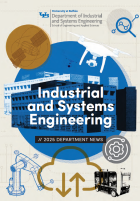Study on innovative water treatment method wins best paper

Aich (left) and Zhou (right) worked with an environmental and water resources engineering alumnus on the study that won Best Paper according to Environmental Science: Nano.
By Peter Murphy
Published August 23, 2022
A study published by a team of researchers, including two faculty members and an alumnus from UB’s School of Engineering and Applied Sciences was identified as a Best Paper according to Environmental Science: Nano.
According to Environmental Science: Nano, the Environmental Science Best Papers Initiative “identifies a variety of excellent papers published in the Royal Society of Chemistry’s Environmental Science journal family, showcasing great research from across the globe.”
Nirupam Aich, assistant professor of environmental and water resources engineering and Chi Zhou, associate professor in industrial and systems engineering co-authored Emerging Investigator series: 3D printed graphene-biopolymer aerogels for water contaminant removal: a proof of concept” with civil and environmental engineering alumnus Arvid Masud (PhD ’21).
“Graphene-based 3D macroscopic aerogels, with their hierarchical porous structures and mechanical strength have been widely explored for removing contaminants from water,” Aich says. “However, their large-scale manufacturing and application in various water treatment processes are limited by their scalability.”
Aich and Masud have examined aerogels in a number of applications related to water treatment. Zhou’s team primarily focused on designing printable ink and a customized 3D printer used during the 3D printing process.
Aich, Masud and Zhou developed a direct ink writing (DIW) 3D printing technique and used freeze-drying to prepare the aerogels for water treatment. These aerogels could be regenerated and reused and were effective in removing solvents during the experiment. According to the researchers, these results could have a significant impact.
“The potential and vision of the 3D printing approach can be extended to other functional nanomaterials,” Aich says. “These findings could materialize the large-scale manufacturing of nano-enabled water treatment devices and technologies.”
While this specific project uses 3D-printed graphene aerogels for water treatment, Zhou believes these materials could have other uses, as well.
“The potential real-world applications are not limited to water contaminant removal,” Zhou says. “These can be used to develop supercapacitors, repair human bones and tissues, and they can be integrated into wearable devices, smart houses and other consumer products.”
This work was referenced as part of Aich’s 2022 CAREER Award from the National Science Foundation (NSF) to develop a novel filtration system that can effectively treat PFAS-contaminated water, and Zhou’s 2019 NSF CAREER Award, “3D Printing of Multiscale Multifunctional Porous Structures by Selectively Freezing Multidimensional Nanomaterials.”
